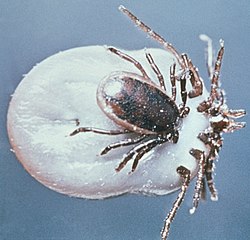History
Over more than a century, disease ecology has evolved drastically. [4] This field comes from the integration of epidemiology, zoology, and public health. [5] The development of disease ecology over time has demonstrated the constantly changing scientific perspective about how pathogens, hosts, and environmental shape patterns of disease. [6] The exact term of "disease ecology" was rather not as popular until the late 20th century, however, its key principles were determined early on through the idea that connected organisms to their environment. [7]
Early foundations: 1800s-1940s

The earliest that the field of disease ecology dates back to is around the time of the germ theory (19th century). [7] [6] This theory established microorganisms as pathogens for infection; [8] however, this was quickly realized that environmental conditions were the main factors that influenced disease patterns. [9] For instance, studies done on malaria showed that the transmission of this disease relied on a parasite called Plasmodium and the ecology of mosquitoes called Anopheles as well as their habitats for breeding. [8] Ronald Ross's mathematical models were one of the first of many attempts to quantify ecological interactions within disease systems. [8] [7] This work laid the foundation for future ecological frameworks. [7] Researchers in the early 20th century studying wildlife diseases saw pathogens as a factor of a bigger ecological community. [10] [7] These diseases consisted of things such as rinderpest in Africa and rabies in carnivores. [11] Disease studies, however, remained for the most part separate from the mainstream of ecology until the mid-20th century. [4] [6]
Development of disease ecology: 1950s-1980s
The shift towards more integrated ideas started in the mid-20th century, when ecologists such as Charls Elton recognized diseases as an ecological force that influences the dynamics of populations, [10] especially after major events such as in the beginning of myxomatosis in European rabbit populations. [11] During the same period, public health scientists that were studying vector-borne diseases began to incorporate ecological methods that examined how land use, climate, and interactions between species influenced transmission cycles. [9] The field of disease ecology further matured through the mathematical modeling work of Anderson and May. Their research integrates host density, reproduction of parasites, immunity, and regulation of populations. [7] These models allowed for a unifying theoretical foundation for disease ecology and continue to influence modern fields such as epidemiology, conservation biology, and public health. [4] [6]
Modern disease ecology and emerging diseases: 1990s-present
In the 1900s and 2000s, outbreaks such as HIV, SARS, Ebola, West Nile virus, and COVID-19 emphasized ecological drivers underlying infectious diseases. [12] [13] Researchers saw that spillover events were strongly influenced by the ecology of wildlife, biodiversity loss, human encroachment, and environmental change. [12] The field of disease ecology became more interdisciplinary, integrating conservation science, global health, climate research, and veterinary medicine. [14] During the same time period, new ecological frameworks suggested that reductions in biodiversity could possibly increase the risk of disease as they favor highly competent reservoir hosts. [4] Improvements and advancements in molecular tools, satellite imaging, and climate modeling, helped to expand the field. [15] [16] This allowed researchers to map disease reservoirs, track the evolution of pathogens, and also predict the risk of outbreaks with precision. [17] In today's modern world, disease ecology is important in order to understand things such as zoonotic spillover, wildlife conservation, and global health. [13] [4] The field's historic progression shows us that diseases are not just a medical phenomenon, rather an ecological process that is influenced by interactions among hosts, pathogens, and the constantly changing environment. [6]
| Part of a series on |
| Biology |
|---|
 |





